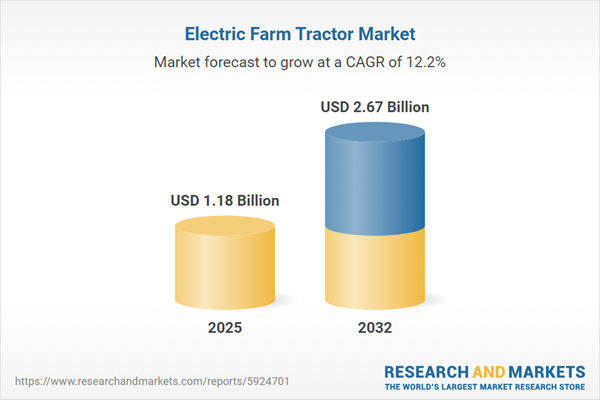Speak directly to the analyst to clarify any post sales queries you may have.
The electric farm tractor market is entering a pivotal growth phase, driven by urgent sustainability priorities and rapid advancement in propulsion technology. Decision-makers in agriculture, investment, and manufacturing must understand how disruptive innovation, evolving regulations, and supply chain shifts are reshaping the market for zero-emission machinery.
Market Snapshot: Electric Farm Tractor Market Size and Growth
The Electric Farm Tractor Market grew from USD 1.06 billion in 2024 to USD 1.18 billion in 2025. It is expected to continue growing at a CAGR of 12.24%, reaching USD 2.67 billion by 2032. This robust trajectory reflects the confluence of policy initiatives, technology adoption, and increased demand for efficient, low-emission agricultural machinery, positioning electric tractors as a critical lever for competitive farm management and long-term industry sustainability.
Scope & Segmentation
- Propulsion: Battery Electric (Lead Acid, Lithium Ion), Hybrid Electric
- Drive Configuration: Four Wheel Drive, Two Wheel Drive
- Operating Runtime: 4-8 Hours, Above 8 Hours, Under 4 Hours
- Autonomy Level: Fully Autonomous, Manual, Semi-Autonomous
- Power Output: 20-50 HP, < 20 HP, >50 HP
- Application: Harvesting, Planting, Tillage
- End-Use: Row Crops, Specialty Crops (Horticulture/Greenhouse, Orchard, Vineyard)
- Regions: Americas (North America: United States, Canada, Mexico; Latin America: Brazil, Argentina, Chile, Colombia, Peru), Europe, Middle East & Africa (including United Kingdom, Germany, France, Russia, Italy, Spain, Netherlands, Sweden, Poland, Switzerland, United Arab Emirates, Saudi Arabia, Qatar, Turkey, Israel, South Africa, Nigeria, Egypt, Kenya), Asia-Pacific (China, India, Japan, Australia, South Korea, Indonesia, Thailand, Malaysia, Singapore, Taiwan)
- Leading Companies: AGCO Corporation, Kubota Corporation, Caterpillar Inc., Deere & Company, Tractors and Farm Equipment Limited, Yanmar Holdings Co. Ltd., and others
Key Takeaways
- Electric farm tractors are transitioning from specialized projects to core agricultural assets, catalyzed by enhancements in high-energy-density batteries and real-time digital systems.
- Policy incentives and emissions regulations are accelerating the shift, with fleets increasingly integrating on-farm renewable energy infrastructure for enhanced resilience.
- Market segmentation shows distinct adoption patterns based on propulsion system, power output, and application, highlighting the need for targeted product strategies for diverse crop, dairy, and livestock operations.
- Regional dynamics are shaped by infrastructure maturity and policy readiness, with rapid pilot deployments in the Americas, dense cooperative procurement in EMEA, and parallel technology innovation in Asia-Pacific.
- Strategic partnerships between OEMs, battery technology firms, and digital service providers are unlocking vertically integrated solutions, accelerating time-to-market and future-proofing product portfolios.
Tariff Impact
New U.S. tariffs imposed from 2025 on imported battery cells, minerals, and certain powertrain components are altering cost and sourcing strategies for electric tractor manufacturers. Manufacturers are pursuing local cell production, battery recycling, and second-life strategies while recalibrating supplier networks. While initial cost increases are moderate, the tariffs are prompting a closer focus on value chain localization and supply chain resilience.
Methodology & Data Sources
This analysis integrates primary interviews with industry executives, direct input from farm operators, and a review of technical literature and market databases. Data points are validated using regression models, scenario analysis, and iterative expert reviews to ensure accuracy regarding market segmentation, regional trajectories, and strategic positioning.
Why This Report Matters
- Enables forward-looking investment and sourcing decisions by analyzing the interplay of technology, policy, and competitive forces in the electric farm tractor sector.
- Supports leadership teams in identifying the most viable market segments, partnership models, and regional deployment tactics for sustained competitive advantage.
- Guides strategic alignment on modular technology integration, supply chain localization, and effective response to evolving regulatory frameworks.
Conclusion
The electric farm tractor market is positioned for accelerated growth and transformation as innovation, partnerships, and regulation shape the next era of agricultural efficiency. Strategic collaboration and agile adaptation will define future success in this evolving sector.
Additional Product Information:
- Purchase of this report includes 1 year online access with quarterly updates.
- This report can be updated on request. Please contact our Customer Experience team using the Ask a Question widget on our website.
Table of Contents
3. Executive Summary
4. Market Overview
7. Cumulative Impact of Artificial Intelligence 2025
Companies Mentioned
The companies profiled in this Electric Farm Tractor market report include:- AGCO Corporation
- Kubota Corporation
- Alke s.r.l.
- Amos Power, Inc.
- Argo Tractors S.p.A.
- Autonxt Automation Pvt. Ltd.
- Buhler Industries Inc.
- Caterpillar Inc.
- Cellestial E-Mobility Private Limited
- CNH Industrial N.V.
- Deere & Company
- EOX Tractors B.V.
- Erisha Agritech Private Limited
- Escorts Kubota Limited
- EVE S.r.l.
- HAV HYBRID AGRI VEHICLE by PROXECTO ENGINEERING SERVICES
- Hon Hai Precision Industry Co., Ltd.
- International Tractors Limited
- MAX GREEN TRACTORS & AGRO EQUIPMENT PVT. LTD.
- Motivo Engineering
- Sabi Agri
- Solectrac Inc.
- Sukoon Solution
- The Escorts Group
- Tractors and Farm Equipment Limited
- VARDEN
- Yanmar Holdings Co. Ltd.
- Zimeno Inc.
- Ztractor Inc.
Table Information
| Report Attribute | Details |
|---|---|
| No. of Pages | 198 |
| Published | November 2025 |
| Forecast Period | 2025 - 2032 |
| Estimated Market Value ( USD | $ 1.18 Billion |
| Forecasted Market Value ( USD | $ 2.67 Billion |
| Compound Annual Growth Rate | 12.2% |
| Regions Covered | Global |
| No. of Companies Mentioned | 30 |









